Honda showed millions of Americans how much fun a compact car with a rev-happy engine and agile handling could be, then somehow lost the plot, ultimately giving us the thoroughly disappointing 2012 Civic. To their credit, Honda heard the alarms, woke up, and worked around the clock--in shifts--to deliver a much-improved 2013 Civic. Of course, if you want to have fun in a Civic you should be getting the Si. But, even with the rushed revisions, has enough of the old magic returned to the 2013 Civic Si to deserve the auto enthusiast adulation its predecessors received? Or are others more in touch with what enthusiasts want in an affordable compact sedan?
For reasons that escape me, the affordable compact sport sedan segment isn't as large as it used to be. The Dodge Dart GT I reviewed last week and the Mitsubishi Lancer GT I'll be reviewing soon can only be included if 200-horsepower isn't a requirement. The plenty poweful, all-wheel-drive Mitsubishi Lancer Ralliart and Subaru WRX, with prices in the upper 20s, aren't all that affordable. The Ford Focus ST and MazdaSpeed3 are only offered as hatchbacks (good for me personally, but not for anyone who wants a trunk). This leaves the Volkswagen Jetta GLI as the most direct match for the Civic Si.
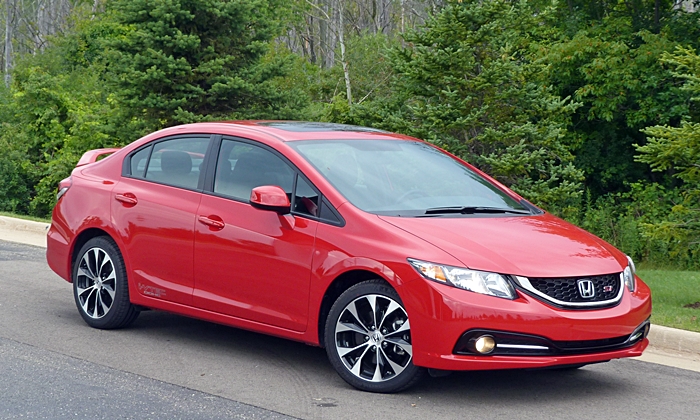
Steeply raked windshield has a few negative side effects, including black plastic trim triangles. more Civic photos
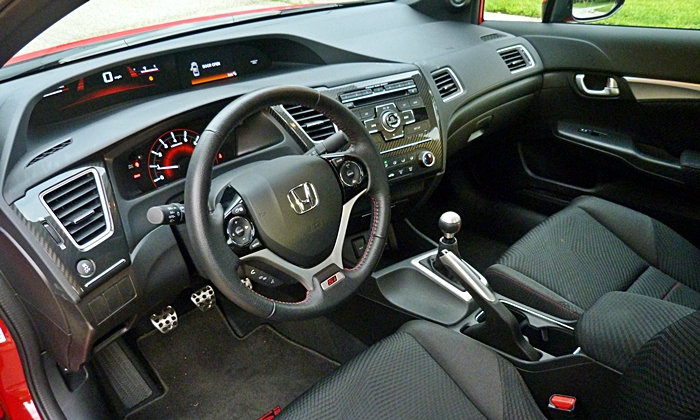
Dramatic upgrade to the interior this year.
| |
Compared to the Jetta |
| Reliability & durability |
 Better
Worse
Better
Worse
|
Judging from responses to our Car Reliability Survey, Volkswagens have become more reliable. But risk-averse car enthusiasts will continue to pick the Civic Si over the Jetta GLI. Though the averages aren't as far apart as they once were, and perceptions likely lag reality, the Civic has been reliable more consistently over the years. Your odds of getting a lemon aren't high with either car, but they're higher with with VW.
We haven't crunched any numbers on the percentage of repairs that are not successful, but my sense is that VWs are also more likely to be difficult to fix if and when they do have problems. Then horror stories appear on the Internet, maintaining the widespread (if not entirely deserved) impression that recent Volkswagens are troublesome.
| Price or payments |
 Better
Worse
Better
Worse
|
With the regular Civic, price was a reason not to buy. Though the price in itself is competitive, adjust for the Civic's relatively low feature content and it no longer looks so good.
Bump the car up to 200 horsepower, and it somehow becomes a better value. You can't buy another compact sedan with this much power for less than the Si's $23,505 base price. The Jetta GLI starts at $24,740. If you want a sunroof and an audio system comparable to the 360-watt system standard in the Honda, you need to add the $2,250 Autobahn Package to the Jetta, making it $3,485 more expensive. Adjusting for the Jetta's additional features (automatic climate control, CD changer, power seat adjustments) narrows the gap to about $2,700. Not close.
Combine this relatively low starting price with slow depreciation and low maintenance costs, and the Civic Si's low total cost of ownership becomes a major draw.
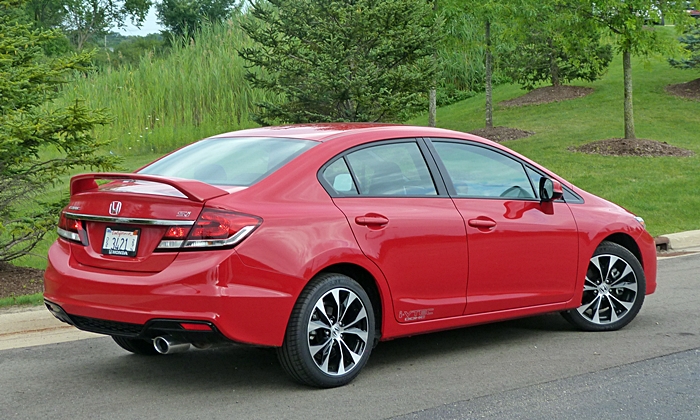
Perhaps the car's best angle. Upgraded tail lamps this year.
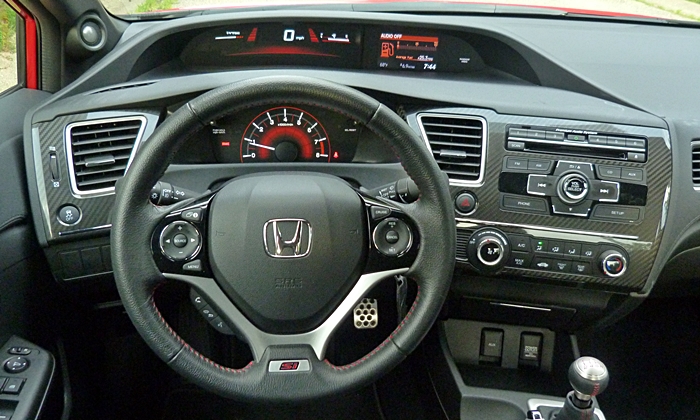
Distinctive bi-level instrument cluster. I'd prefer the tach up with the speedometer.
| Powertrain performance |
 Better
Worse
Better
Worse
|
I almost created a new category to capture the Honda Civic Si's dynamic strengths. The car has never been about brute acceleration. Power through revs rather than engine size or boost was the Honda way. The 2006-2011 Civic Si relied upon a high-strung 2.0-liter four-cylinder good for 197 horsepower at a lofty 7,800 rpm. Meanwhile, competitors were transitioning to turbocharged engines that, even when they didn't produce much more peak power (and, aside from the 200-horse VW, they did) were much stronger at low-to-moderate engine speeds.
Honda's response with the 2012 Civic Si was a 2.4-liter engine from the Acura TSX that produces just a bit more horsepower (201 at 7,000 rpm), but considerably more torque at a much lower peak rpm (170 lb-ft at 4,400 rpm vs. 139 lb-ft at 6,200 rpm). This engine remains more peaky than the boosted mill in the Jetta GLI (207 lb-ft available as low as 1,700 rpm), but gets its car to 60 mph at least as quickly (about seven seconds).
Bigger isn't entirely better. Though the new, larger engine still undergoes a personality change when the high-lift cam lobes kick in (at 5,000 rpm), it doesn't have the same zing as the old one. There a certain thrill in revving to 8,000 rpm that can't be obtained at 7,000. On the other hand, you no longer have to rev the crap out of the Si just to get to the grocery store. A worthwhile trade-off? Depends on how much you like to shift.
If you don't enjoy shifting the Civic Si, then you're not going to enjoy shifting any car. Shift throws are short and tight, with a distinct snick as you engage the new gear, yet could hardly be smoother. Six short, closely-spaced gears mean that an ideal ratio is always just a quick snick away. With the immediate responses a turbocharged engine can't match and a thrilling (yet in no way unrefined) snarl once the big cam lobes come into play, the Civic Si's engine pairs very well with such a tight, slick shifter. The subjective experience of working this powertrain from gear to gear, not anything that can be quantified, is the best thing about driving the Civic Si. (Unless you've just gotten into the car on a sunny day. Then the metal shift knob scorches your hand.)
Don't want a manual, even one that is such a delight to shift? Then, unlike in the Jetta GLI, you're out of luck.
| Front seat support & comfort |
 Better
Worse
Better
Worse
|
You can't get leather upholstery in the Civic Si, but the standard cloth is so attractive and grippy that you won't miss it. (Hopefully you also won't miss seat heaters.) Combine this cloth with firm, properly spaced side bolsters, and the Civic Si's front buckets provide much better lateral support in hard turns than the flatter, slicker seats in the Jetta GLI. With a distinctively Honda shape and firmness, front seat comfort is also good (assuming you're not too broad for the bolsters).
This said, some people will wish for more seat adjustments. The Jetta GLI's front seats include power four-way lumbar and power recline. In the Civic Si, the lumbar bulge isn't adjustable and the manual recliner might not include your ideal angle.
| Interior styling |
 Better
Worse
Better
Worse
|
Not everyone will like how the Civic Si looks inside, with a starship-bridge-inspired bi-level instrument panel, metal-look trim, and red stitching on highly textured black cloth seats. But even those who don't care for the look will find the 2013's instrument panel a huge improvement over the craptastic gray plastic in the 2012. (Is the fake stitching necessary? Probably not, but I didn't mind it personally.) Those who do like the sci-fi styling tend to love it. The Jetta will appear more tasteful inside to some, but more boring inside to all.
| |
Compared to the Jetta |
| Handling |
 Better
Worse
Better
Worse
|
In most aspects the Civic Si tackles curves very well, so I almost didn't include handling among the "why nots." Especially with the optional Michelin Pilot Sport 3 tires, the Civic Si's chassis has high limits, below which you'll experience hardly any understeer. A limited-slip differential prevents wheelspin when accelerating out of turns.
Best of all, light steering via a small-diamter wheel helps the Civic Si feel more agile than competitors, especially the Jetta. The Volkswagen is a few inches longer (182 vs. 179) and a little heavier (3,124 vs 2,967), but it feels much larger and heavier. If agility is your thing, then the Civic Si is one of the increasingly rare places you'll find it.
But the car's steering is also its weakest aspect. It feels loose on-center, communicates little, and doesn't load up naturally as the wheel is turned. Consequently, it conveys little sense of which direction the front tires are pointing or how well they are gripping. Getting anywhere near the car's high limits requires more confidence than the steering provides. A touch of float in quick transitions doesn't help. Body motions are more tightly controlled in the Jetta. The Volkswagen's steering (via a much larger but nicely shaped wheel) isn't much more communicative, but it is more naturally weighted and consequently more intuitive.
| Feature availability |
 Better
Worse
Better
Worse
|
Only two options are offered on the Civic Si, high-performance tires and a nav system (the latter with buttons that are hard to distinguish at a glance). So while the base car is fairly well equipped, many features offere elsewhere simply aren't available on the Civic Si. I've already mentioned the lack of seat adjustments and absence of leather from the options list. You also cannot get heated seats, proximity key, xenon headlights, or any of the latest safety nannies aside from the standard rearview camera. Don't want any of this stuff anyway? Then this issue isn't an issue.
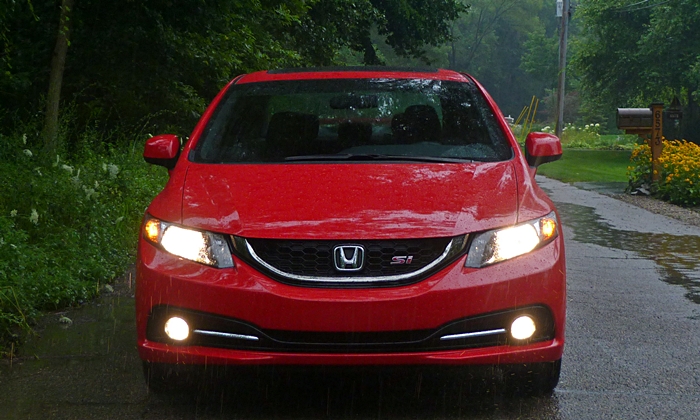
A classier face through chrome this year.
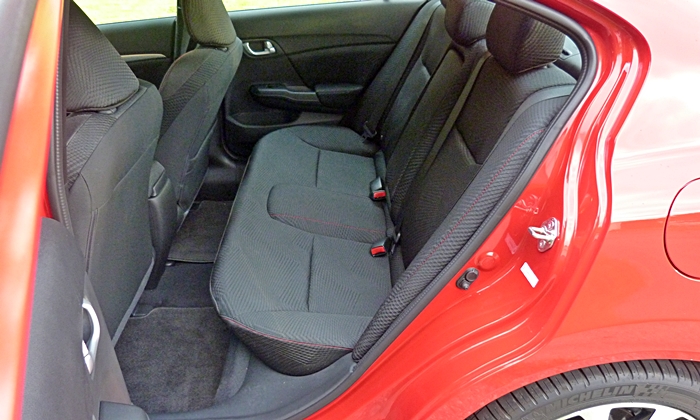
Roomy rear seat, and virtually no hump in the floor.
| Driving position & visibility |
 Better
Worse
Better
Worse
|
Hondas used to be renowned for their fantastically low instrument panels, and the outstanding forward visibility these enabled. So I'm more critical of the tall, deep, bi-level instrument panel in recent Civics than I might be in other cars. The view forward is better than might be expected given the extreme depth of the instrument panel. Honda has disguised this depth well. But I'd prefer a view forward more like that in pre-2006 Civics or even in the current Accord.
The instrument panel in the Jetta is also fairly tall, but owing to a more upright windshield it isn't nearly as deep. Not even a hint of tunnel vision here.
| Exterior styling |
 Better
Worse
Better
Worse
|
I retain reservations about the Civic's exterior. A new, chrome-bordered grille helps, but a black plastic triangle remains at the base of the A-pillar. It's there because of the windshield's extreme rake, but what's the point of this? The previous-generation Civic's exterior still looks at least as futuristic, while being cleaner, more fluid, and simply more attractive. Even if Honda now recognizes this, the A-pillar would take far more time and money to redesign than the grille, so this didn't happen.
| |
Compared to the Jetta |
| Fuel economy |
 Better
Worse
Better
Worse
|
Eith EPA ratings of 22 mpg city and 31 mpg highway--on premium fuel--the Civic Si's fuel economy lags that in many larger cars that are at least as powerful. Much of the blame goes to the short gearing. A manual transmission Jetta GLI, with a turbo but taller gearing, manages a bit better, 22/33.
But maybe Civic Si just doesn't get along with the EPA's tests. Even when I was pushing the car pretty hard the trip computer reported averages in the mid-20s. Ease up, and 30 was easily attained. And when I drove the car like I would a Prius, 40 happened. I also observed nearly 40 in a 70-mph highway drive. I'd wonder about the accuracy of the trip computer, except the fuel gauge (which for some reason goes from F to E rather than E to F) didn't move much.
In my week with a Jetta GLI its trip computer reported averages from 22 to 32, with 24 the norm in suburban driving. So, assuming both trip computers are equally accurate, the Honda has a real-world edge.
| Ride smoothness |
 Better
Worse
Better
Worse
|
For a performance-oriented compact car, the Honda Civic Si rides very well. Some roads with uneven surfaces felt bumpy, but these were the exception rather than the rule. In comparison, the Jetta GLI feels almost harsh, with much sharper reactions to small bumps and chuckholes.
| Quietness |
 Better
Worse
Better
Worse
|
The Civic Si still isn't a quiet car, but the revisions for the 2013 have made it a quieter one. There's still some road noise, especially on concrete, but it's nowhere near the levels in past Civics. You also won't hear tire impacts nearly as loudly as in the Jetta GLI.
| Rear seat room & comfort |
 Better
Worse
Better
Worse
|
The Civic has one of the roomiest rear seats in the segment. Any adult center passenger will appreciate that the floor is nearly flat. The Jetta has even more rear legroom, though.
| Controls and instruments |
 Better
Worse
Better
Worse
|
A parting word on the Civic Si's bi-level instrument cluster. The forward, above-the-rim location of the speedometer makes it very easy to read at a glance. Consider it the poor man's head-up display. Problem is, the location of the tach, closer and within the steering wheel rim, isn't nearly as good. Honda has compensated by placing a series of lights, the last two red rather than yellow, next to the speedometer. I relied on these far more than I did the tach. But ideally the tach would be up there, perhaps instead of the fuel gauge and trip computer. The resulting instrument cluster wouldn't look as cool, but it would be more functional.
Another design choice negatively affects the Civic Si's best part: the shifter's metal cap gets painfully hot in direct sunlight. Bring driving gloves.
The Honda Civic Si has some distinctive strengths, most notably supportive seats, agile handling, and a powertrain that delights when going from gear to gear. It's also relatively cheap to own, economical, reliable, and roomy. I'm willing to accept that some people love the unique, sporty, high-tech look of the interior now that its materials have been dramatically upgraded. The exterior continues to need work, but it's not a deal-killer (unless you absolutely cannot abide the fakery of those black plastic triangles).
All in all, the Civic Si remains a car enthusiasts can appreciate. But its not quite good enough to deserve past levels of devotion. Honda could have enlarged the engine without sacrificing as much of its high-winding character. How about a 230-plus-horsepower 2.4-liter? Even more than that, the car needs communicative, properly-weighted, confidence-inspiring steering. Make the steering as good as the shifter, and the Civic Si would be the sport compact to get.
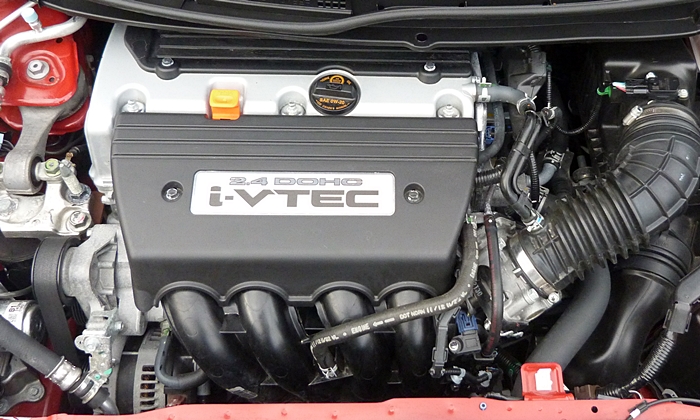
Doesn't rev as high as before, but much stronger mid-range.
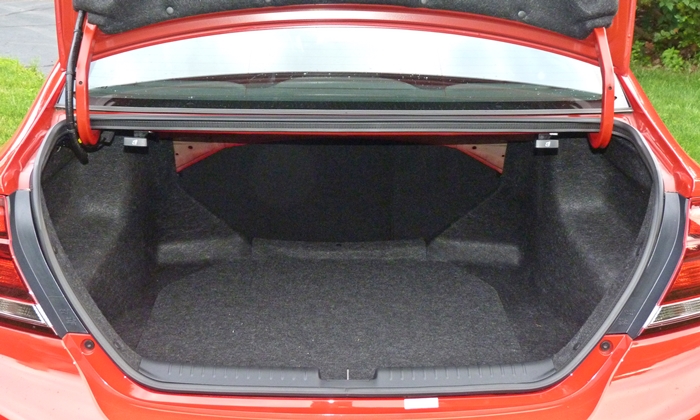
About average. Jetta's is more spacious (15.5 vs. 12.5 cubic feet).
See more 2013 Honda Civic photos
Honda and Volkswagen each provided insured cars for a week with a tank of gas.











